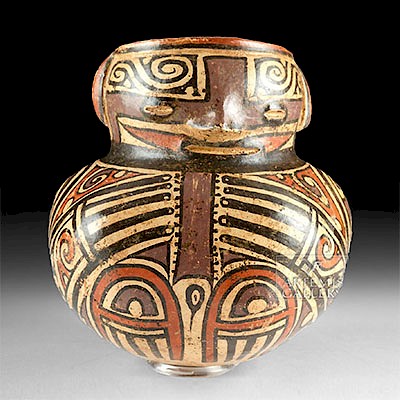Moche Bichrome Stirrup Vessel - Warrior / Trophy Head
Lot 63b
About Seller
Artemis Fine Arts
686 S Taylor Ave, Ste 106
Louisville, CO 80027
United States
Selling antiquities, ancient and ethnographic art online since 1993, Artemis Gallery specializes in Classical Antiquities (Egyptian, Greek, Roman, Near Eastern), Asian, Pre-Columbian, African / Tribal / Oceanographic art. Our extensive inventory includes pottery, stone, metal, wood, glass and textil...Read more
Estimate:
$1,700 - $2,550
Absentee vs Live bid
Two ways to bid:
- Leave a max absentee bid and the platform will bid on your behalf up to your maximum bid during the live auction.
- Bid live during the auction and your bids will be submitted real-time to the auctioneer.
Bid Increments
| Price | Bid Increment |
|---|---|
| $0 | $25 |
| $300 | $50 |
| $1,000 | $100 |
| $2,000 | $250 |
| $5,000 | $500 |
| $10,000 | $1,000 |
| $20,000 | $2,500 |
| $50,000 | $5,000 |
| $100,000 | $10,000 |
| $200,000 | $20,000 |
About Auction
By Artemis Fine Arts
Nov 8, 2018
Set Reminder
2018-11-08 10:00:00
2018-11-08 10:00:00
America/New_York
Bidsquare
Bidsquare : Ancient / Ethnographic From Around The World
https://www.bidsquare.com/auctions/artemis-gallery/ancient-ethnographic-from-around-the-world-3598
Ancient art from Egypt, Greece, Italy and the Near East, as well as Asian, Pre-Columbian, Native American, African / Tribal / Oceanic, Spanish Colonial, Russian Icons, Fine art, much more! Artemis Fine Arts info@artemisgallery.com
Ancient art from Egypt, Greece, Italy and the Near East, as well as Asian, Pre-Columbian, Native American, African / Tribal / Oceanic, Spanish Colonial, Russian Icons, Fine art, much more! Artemis Fine Arts info@artemisgallery.com
- Lot Description
Pre-Columbian, North Coast Peru, Moche, late Moche I to early Moche II, ca. 100 BCE to 300 CE. A beautiful bichrome pottery vessel with a planar base, globular body, an arching stirrup-shaped handle, and a tubular spout with an angular lip. Each side of the cream-slipped vessel displays a victorious standing abstract warrior, dressed in a vertically striped tunic with sinuous tassels projecting from either side, with a triangular head defined by a toothy grin, circular eyes, petite ears, and a plumed headdress. Each figure hold a ceremonial tumi in one hand and the hair of a severed trophy head in the other. Warfare and warriors are recurrent themes in Moche art, a strong testimony to the violence of Moche society which was riven by intense inter-rivalry competition. It was common after battle for triumphant warriors to ceremonially sever the heads of the loser, hence why trophy head motifs are so common in Moche artistry. A fabulous example replete with careful attention to detail and an intriguing presentation. Size: 5" W x 7.125" H (12.7 cm x 18.1 cm).
The Moche were masterful ceramicists. Most of their vessels were mold made standard shapes and forms. However, iconographically their decorations boasted a rich range of subjects. Some were embellished with stylized, abstract, and violent motifs as we see in this example. In addition, human subjects were depicted, in some cases as portrait vessels, others as representative warriors, rulers, healers, etc. There was a ritual element to Moche warfare too: prisoners had to be captured to make sacrifices to the gods. This figure seems to be an ordinary warrior rather than a lord, as the latter are usually depicted wearing domed helmets.
Scholars disagree as to their functionality and use of vessels like this example. Until recently most believed these vessels to be funerary wares. However, some argue that they were created for domestic purposes, feasts, rituals, or other ceremonial uses. The research continues and fortunately we have pieces such as this example to serve as a window upon the ancient world.
For similar examples of trophy head motifs, please see: Donnan, Christopher B., and Donna McClelland. Moche Fineline Painting: Its Evolution and Its Artists. University of Washington Press, 2002, pp. 31 (fig 2.15), pp. 24 (fig 2.20).
Provenance: private California, USA Collection
All items legal to buy/sell under U.S. Statute covering cultural patrimony Code 2600, CHAPTER 14, and are guaranteed to be as described or your money back.
A Certificate of Authenticity will accompany all winning bids.
We ship worldwide and handle all shipping in-house for your convenience.
#135136Handle and portion of spout reattached with light resurfacing and overpainting along break lines. Surface wear and abrasions commensurate with age as expected, minor nicks to rim, handle, body, and base, and some fading to pigmentation. Light earthen deposits and great mineral deposits throughout.Condition
- Shipping Info
-
All shipping is handled in-house for your convenience. Your invoice from Artemis Gallery will include shipping calculation instructions. If in doubt, please inquire BEFORE bidding for estimated shipping costs for individual items.
-
- Buyer's Premium



 EUR
EUR CAD
CAD AUD
AUD GBP
GBP MXN
MXN HKD
HKD CNY
CNY MYR
MYR SEK
SEK SGD
SGD CHF
CHF THB
THB

















